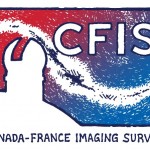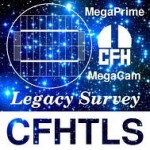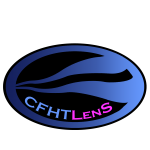Martin Kilbinger
EUCLID SCIENTIST

| Contact Information | |
| E-mail: | martin.kilbinger [at] cea [dot] fr |
| Phone: | +33 (0)1 69 08 17 53 |
| Office: | 283 |
| Affiliation: | IRFU/DAp-AIM, IAP |
Research Interests
My research field is cosmology, in particular weak gravitational lensing. I work on observational data from large galaxy surveys to constrain cosmological models and to infer information about dark matter and dark energy. To learn more about this topic, have a look at my (technical) review here or check the video abstract on the companion web page.
I have been using cosmic shear, the distortion of galaxy images by the large-scale structure in the Universe, to measure cosmological parameters. Within the CFHTLenS collaboration (2008 - 2014), I have contributed to constraining dark matter, dark energy and modified gravity. Currently, I work on the UNIONS imaging survey. I am also involved in the ESA space mission Euclid, launched on July, 1, 2023 from Cape Canaveral, which is expected to improve those constraints by orders of magnitude. Using cross-correlations between lensing and density tracers such as galaxies or galaxy clusters, we can learn about the relationship between luminous and dark matter. Some of my research includes measuring the relationship between the mass of supermassive black holes and their host halo mass.
To efficiently explore the high-dimensional parameter space for cosmological inference, I have been working on sampling methods, such as Population Monte Carlo (PMC), and Approximate Bayesian Computation (ABC; here), and, more recently, Neural Density/Likelihood/Posterior Estimation (NDE/NLE/NPE).
Weak cosmological lensing
The main observable for cosmological weak lensing is cosmic shear, the distortion of galaxies by the large-scale structure in the Universe. For results from CFHTLenS see the published papers. I have been working on second- and higher-order statistics in real space, and shear tomography. For projects at CosmoStat within Euclid see this page.
One particularly interesting weak-lensing observable are peak counts. This higher-order statistic is sensitive to the non-Gaussian aspects of the large-scale structure. Together with Chieh-An Lin, I have developed a new model prediction approach for peak counts. We have compared this model to N-body simulations, explored its stochastic nature for strategies to constrain cosmological parameters, and looked at different filtering techniques.
Dark matter, galaxies, and galaxy clusters
We still have to learn a lot about the relation between galaxies and dark matter and how galaxies form and evolve in dark-matter structures. This relation can be studied by combining weak gravitational lensing and galaxy clustering statistics. This can help us to understand when and in which galaxies residing in dark-matter halos stars are formed efficiently.
We used weak lensing to measure masses of galaxy clusters in XXL and SDSS, which is an important step for cosmological analyses using the number of clusters in mass and redshift.
Sampling the likelihood
I have been developing and implementing the sampling method Population MonteCarlo (PMC) which is an efficient and massively parallelizable method to sample from an arbitrary posterior distribution. PMC readily provides an estimate of the Bayesian evidence. Recently, I have looked into the likelihood-free technique Approximate Bayesian Computation (ABC) and other likelihood estimation methods, together with Chieh-An Lin, and, more recently with Emille Ishida and Jessi Cisewski.
Jobs
Please check the CosmoStat job page for offers.
Collaborations and projects
 Euclid is a large ESA space mission that was launched to L2 on July, 1, 2023 from Cape Canaveral. The main goal of Euclid is to map galaxies and dark matter in the Universe, and to constrain the nature of dark energy. I am working on the weak-lensing analysis of Euclid, and science-level (Level 3) data processing and validation.
Euclid is a large ESA space mission that was launched to L2 on July, 1, 2023 from Cape Canaveral. The main goal of Euclid is to map galaxies and dark matter in the Universe, and to constrain the nature of dark energy. I am working on the weak-lensing analysis of Euclid, and science-level (Level 3) data processing and validation.
 The Canada-France Imaging Survey, a 5,000 deg2 survey in the Northern Hemisphere. The proposal was accepted in 2016, observations have started in early 2017. Lensing-related science with CFIS is galaxy-galaxy lensing to study properties of dark matter halos (here), filaments, satellite galaxy stripping, and tests of General Relativity.
The Canada-France Imaging Survey, a 5,000 deg2 survey in the Northern Hemisphere. The proposal was accepted in 2016, observations have started in early 2017. Lensing-related science with CFIS is galaxy-galaxy lensing to study properties of dark matter halos (here), filaments, satellite galaxy stripping, and tests of General Relativity.
 CFHTLS (Canada-France Hawaii Telescope Legacy Survey) is a deep and wide imaging survey of 170 square degrees in five optical bands, observed between 2003 and 2009 with the wide-field camera MegaCam on the 3.6m telescope CFHT.
CFHTLS (Canada-France Hawaii Telescope Legacy Survey) is a deep and wide imaging survey of 170 square degrees in five optical bands, observed between 2003 and 2009 with the wide-field camera MegaCam on the 3.6m telescope CFHT.
CFHTLenS (Canada-France Hawaii Telescope Lensing Survey) is the weak-lensing collaboration using data from the CFHT legacy survey.
Software
- ShapePipe, a pipeline to processes wide-field images for weak lensing. The end product of ShapePipe is a catalog containing information for each galaxy, including its shape parameters, i.e. ellipticity. This catalog also contains shapes of artificially sheared images, which can be used in post-processing to compute calibrated shear estimates via metacalibration. Software paper, ascl link.
- shear_bias, a small package that contains tools and scripts for shear bias estimation for weak gravitational lensing analysis, implementing the method of https://arxiv.org/abs/1806.10537..
- Camelus, a model for weak-lensing peak counts. The code comes with statistical analysis tools for cosmological parameter constraints. In particular, it exploits the stochastical nature of the model predictions using Approximate Bayesian Computation (ABC). [Main author is Chieh-An Lin.]
- CosmoPMC, Cosmology sampling with Population Monte Carlo, an adaptive importance-sampling method to explore high-dimensional posteriors to estimate parameter constraints and the Bayesian evidence. CosmoPMC comes with various cosmology modules such as weak lensing, galaxy clustering, SNIa, BAO distance priors and CMB (via CAMB/WMAP software). The cosmology module is based on nicaea.
The most recent version is 1.2 (December 2012). The user's guide is on the archive (v3).
- athena, a tree code to calculate second-order correlation functions, including shear-shear ("cosmic shear"), shear-position ("galaxy-galaxy lensing") and position-position (spatial angular correlation).
The most recent version is 1.7 (March 2014).
- nicaea: NumerIcal Cosmology And lEnsing cAlculations. It involves basic cosmology functions (distances, growth factor), dark-matter power spectrum and lensing observables (power spectrum, second-order shear statistics). The non-linear power spectrum are the Peacock&Dodds (1996) and Smith, Peacock et al (2003) fitting formulae. The code is easy to use and fast enough to be used for Monte-Carlo sampling.
The most recent version is 2.5 (October 2014).
- C-program to calculate the filter function and E-/B-mode shear function described in arXiv:0907.0795.
- Code for reduced-shear correction fits as in arXiv:1004.3493.
Outreach
Press releases
2015. Review on cosmological constraints from cosmic shear. In French: Irfu.
2015. First published papers from the XXL survey: ESA.
2013. Cosmological constraints on dark matter and modified gravity from CFHTLenS weak lensing: at CEA. In French: Irfu.
2012. Astronomers reach new frontiers in dark matter. ROE.
2010. Independent evidence of the accelerated expansion of the Universe, with weak lensing in COSMOS: In French: CNRS.
2008. The largest structures ever measured thanks to weak lensing in CFHTLS: CFHT. In French: IAP.
Videos
Video abstract of my cosmic shear review, see this page.
Lecture Notes and Talks
- Weak-lensing lectures at École Polytechnique, from 08/11/2022, 01/10/2019, 13/11/2018, and 14/11/2017.
- Weak-lensing lecture notes from the DarkMod workshop, at IPhT Saclay/IAS Orsay, 09/2017.
- Weak-lensing lecture notes from the most recent Euclid summer school in cosmology, 2019 in Banyuls. Parts I, II, and exercise sets can be downloaded from this page. Previous versions are from 2018 (Roscoff), 2017 (Fréjus), and 2016 (Narbonne; only part I). Those previous slides are available here, here, and here.
- Review talk on cosmic shear, from 2010: From ellipticities to cosmological parameters from the DUEL meeting at Ringberg.
- Lecture notes "Bayesian statistics and model selection" from a lecture I held at Shanghai Normal University in August 2009.
- Download the weak lensing lecture I've given at the IPM Cosmology School 2007 in Tehran.
[ Lecture (15MB) | Part 1 (750kB) (WL by the LSS) | Part 2 (6.7MB) (WL & cosmology) | Part3 (8.6MB) (Observing WL)]
External Links
Class, the Cosmic Linear Anisotropy Solving System, by Julien Lesgourgues et al.
What might happen at The end of the Universe?
The 2004 Saas Fee lensing lecture notes, that were published in the book:Kochanek, C.S., Schneider, P., Wambsganss, J.: Gravitational Lensing: Strong, Weak & Micro. G. Mey- lan, P. Jetzer & P. North (eds.), Springer-Verlag: Berlin, p.273
Download Part I (Introduction) and Part III (Weak gravitational lensing), by Peter Schneider.
Non-Science Stuff
Check out my piano music: videos and music scores available

